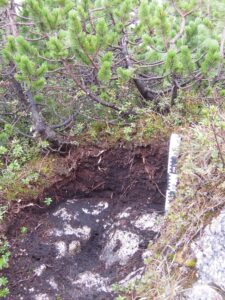The thickness of the organic layer may vary from >15 cm up to >100 cm. The occurrence of thick organic layers is described predominantly on limestone and dolomite, rarely on silicate rocks. Tangel occurs particularly in montane to subalpine zones with high precipitation. The typical Tangel frequently occurs where transitions to moist or hydromorphic humus forms are observed. So far, Tangel humus forms are insufficiently studied, and soil data are rarely presented. Therefore, no further subdivision is provided, and in the first instance, only Tangel on limestone with an Ovh horizon is defined. It can be expected that transitional types to Mor or other Moder subtypes will occur, as well as Tangel humus form on unconsolidated rock. Distinct features are:
-
Ol horizon is present all year round;
-
Of horizon is present all year round and thin (<5 cm);
-
Obh horizon is present, with diffuse boundary with underlying Ovh; and
-
Ovh horizon is present and directly overlies the C horizon.
Organic surface layer of a Tangel under mountain pine (Pinus mugo) on limestone
(Photo: Gerhard Milbert).

